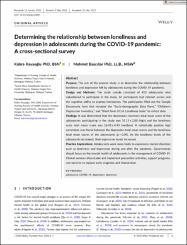| dc.contributor.author | Kayaoğlu, Kübra | |
| dc.contributor.author | Başcıllar, Mehmet | |
| dc.date.accessioned | 2022-07-01T07:47:21Z | |
| dc.date.available | 2022-07-01T07:47:21Z | |
| dc.date.issued | 2022 | en_US |
| dc.identifier.citation | Kayaoğlu, K., & Başcıllar, M. (May 30, 2022). Determining the relationship between loneliness and depression in adolescents during the COVID-19 pandemic: A cross-sectional survey. Journal of Child and Adolescent Psychiatric Nursing : Official Publication of the Association of Child and Adolescent Psychiatric Nurses, Inc. | en_US |
| dc.identifier.issn | 1073-6077 | en_US |
| dc.identifier.issn | 1744-6171 | en_US |
| dc.identifier.uri | https://doi.org/10.1111/jcap.12384 | |
| dc.identifier.uri | https://hdl.handle.net/20.500.12899/1148 | |
| dc.description | Kübra Kayaoğlu, Department of Nursing, Faculty of Health Sciences, Malatya Turgut Ozal University, Battalgazi, Malatya, Turkey. Mehmet Başcıllar, Social Work Department, Faculty of Health Sciences, Malatya Turgut Ozal University, Battalgazi, Malatya, Turkey. | en_US |
| dc.description | Formerly known as:Journal of child and adolescent psychiatric and mental health nursing | en_US |
| dc.description | Received: 12 January 2022. Revised: 9 May 2022. Accepted: 15 May 2022. | en_US |
| dc.description.abstract | Purpose: The aim of the present study is to determine the relationship between loneliness and depression felt by adolescents during the COVID-19 pandemic. Design and Methods: The study sample consisted of 423 adolescents who volunteered to participate in the study. All participants had internet access and the cognitive ability to express themselves. The participants filled out the Google Documents form that included the “Socio-demographic Data Form,” “Children's Depression Inventory,” and “Short-form UCLA Loneliness Scale” to collect data. Findings: It was determined that the depression inventory total mean score of the adolescents participating in the study was 55.15 ± 2.88 (high) and the loneliness scale total mean score was 16.43 ± 4.93 (medium). A statistically positive high correlation was found between the depression total mean scores and the loneliness total mean scores of the adolescents (p < 0.05). As the loneliness levels of the adolescents increased, their depression levels increased. Practice Implications: Adolescents were more likely to experience mental disorders such as loneliness and depression during and after the pandemic. Governments should focus on the mental health of adolescents in the management of COVID-19. Clinical services should plan and implement prevention activities, support programs, and services to replace early diagnosis and intervention. | en_US |
| dc.language.iso | en | en_US |
| dc.publisher | Wiley | en_US |
| dc.relation.ispartof | Journal of Child and Adolescent Psychiatric Nursing | en_US |
| dc.rights | info:eu-repo/semantics/embargoedAccess | en_US |
| dc.subject | Adolescent | en_US |
| dc.subject | COVID-19 | en_US |
| dc.subject | Depression | en_US |
| dc.subject | Loneliness | en_US |
| dc.title | Determining the relationship between loneliness and depression in adolescents during the COVID-19 pandemic: A cross-sectional survey | en_US |
| dc.type | Article | en_US |
| dc.authorid | 0000-0001-5170-3935 | en_US |
| dc.authorid | 0000-0002-0223-8050 | en_US |
| dc.department | MTÖ Üniversitesi, Sağlık Bilimleri Fakültesi, Hemşirelik Bölümü | en_US |
| dc.institutionauthor | Kayaoğlu, Kübra | |
| dc.institutionauthor | Başcıllar, Mehmet | |
| dc.identifier.doi | 10.1111/jcap.12384 | |
| dc.identifier.startpage | 1 | en_US |
| dc.identifier.endpage | 8 | en_US |
| dc.relation.publicationcategory | Makale - Uluslararası Hakemli Dergi - Kurum Öğretim Elemanı | en_US |
| dc.identifier.scopusquality | Q2 | en_US |
| dc.indekslendigikaynak | Web of Science | en_US |
| dc.indekslendigikaynak | Scopus | en_US |


















